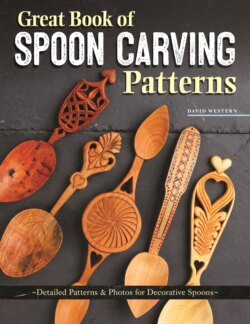Читать книгу Notes from a Swedish Kitchen - David Western - Страница 9
На сайте Литреса книга снята с продажи.
Woods
ОглавлениеEach region of Europe has a species of tree that supplies carvers the main lumber for spoons carved in that area. The most popular woods tend to be deciduous (hardwood) timbers, which are on the softer end of the hardness scale while remaining sturdy enough to take detailing and withstand the forces of repetitive carving activity. Softwoods such as pines, fir, or cedars can also be used, but they have to be carefully selected, as they are frequently too soft and stringy for use as spoons.
For modern carvers wishing to emulate the woods of yore (detailed below), the most commonly available woods today are birch, linden, sycamore, bigleaf maple, red alder, cherry, and walnut. Boxwood and holly are good for smaller spoons that will be inlaid with wax, but these particular woods can be difficult to find, so fruitwoods and maple make a good substitute.
Generally, woods of lighter color tone and homogenous grain tend to be more suited for the elaborate detail common to romantic spoon carving. Woods with heavy grain patterns, such as oak and ash, can sometimes overwhelm delicate designs, so these are best used only for robust carvings.
In Scandinavia, the main wood used was birch, which, with its creamy coloration and even grain, is perfectly suited for the complex chainwork and intricate detailing so popular among carvers there. Birch cuts smoothly and rarely splinters, which makes it particularly suited for both bowl carving and incised detail work.
In Wales, the most popular wood for lovespoons was sycamore; it also features a light, creamy color and an even grain. Both birch and sycamore are relatively quickgrowing species that were popular for fuel and were utilized to make everything from boxes to furniture.
The Bretons were celebrated for their remarkable and complex wax inlay work and so gravitated to denser and more homogenous woods, such as boxwood, apple, and cherry. These woods are harder and much more difficult to carve than birch and sycamore, but they cut extremely cleanly and leave the nice, smooth cuts that are so perfect for accommodating wax inlay.
In the Alpine regions of Europe, the classic woodcarvers’ timber was linden (also known as lime in the UK and basswood in the US), but, at higher altitudes, several species of spruce and pine were also commonly carved. Birch grows in the lower regions and was also used for spoons and kitchen items.
Bigleaf maple
Birch
Cherry
Eastern maple
Pine
Poplar
Red alder
